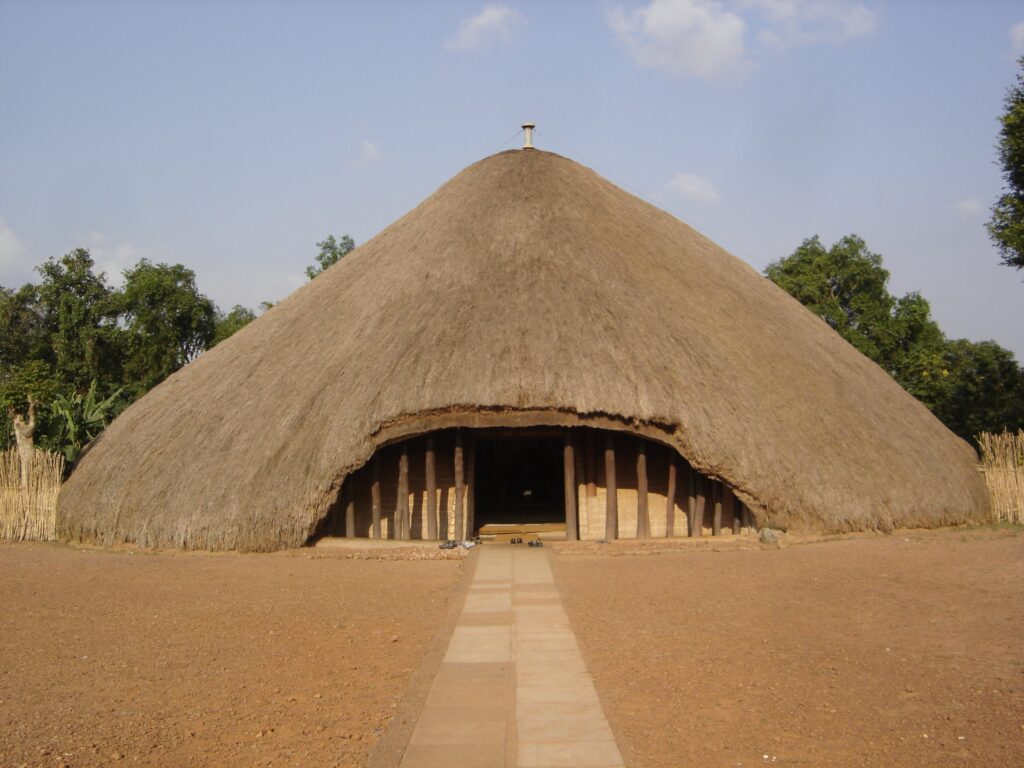Kasubi Tombs

Preserving Cultural Heritage: The Architectural Marvel of Kasubi Tombs and its Reconstruction After Devastating Fires
Nestled in the heart of Uganda lies a cultural gem, the Kasubi Tombs, a UNESCO World Heritage Site renowned for its architectural splendor and historical significance. However, this revered site faced a tragic fate when engulfed by flames in [mention the year], leaving the world in shock and mourning. Yet, amidst the ashes, a tale of resilience and dedication unfolded as efforts to reconstruct this iconic landmark began, reaffirming the importance of preserving cultural heritage.
A Glimpse into History of Kasubi Royal Tombs.
The Kasubi Tombs hold profound cultural and spiritual significance for the Baganda people of Uganda. Constructed in the late 19th century, this architectural masterpiece served as the burial grounds for the Kabakas, the traditional kings of the Buganda Kingdom. The site embodies the rich traditions, beliefs, and practices of the Baganda people, showcasing their reverence for ancestors and the spiritual realm.
Location of Kasubi Royal Tombs.
The Tombs of the Buganda Kings at Kasubi are located on Kasubi hill of Rubaga Division in Kampala, the Ugandan capital. They occupy a 24 hectare site that has been used by the Baganda for its Royal Tombs since the 13th century, and represents the spiritual heart of the Baganda people. Sadly, the tombs were completely destroyed by fire in March 2010, just eight years after the site was inscribed on the world heritage list. Fortunately, the original burial system of the Kabakas (kings) of Buganda is being maintained and the building’s traditional architectural craftsmanship and the required skills are still available to allow it to be recreated.
Architecture and Cultural Symbolism of Kasubi Tombs

The architectural design of the Kasubi Tombs is a testament to the ingenuity and craftsmanship of the Baganda artisans. The main structure, known as the Muzibu Azaala Mpanga, is a circular building with a thatched roof, supported by wooden pillars and walls made of wattle and daub. This traditional construction technique not only reflects the cultural heritage of the Baganda people but also highlights their harmonious relationship with nature.
The tombs are not merely physical structures but repositories of cultural knowledge and spiritual energy. Every element, from the layout of the site to the intricate carvings adorning the buildings, is imbued with symbolic meaning, reinforcing the Baganda’s connection to their ancestors and the spirit world.
The Kings of Buganda who were buried in Kasubi Tombs.
The Kasubi tombs is the burial ground for the dead Buganda kings. They are also called “Basekabaka” meaning dead Kings in Luganda. The following are the kings who were buried in the Tombs.
Muteesa I Mukaabya Walugembe Kayiira (1837–9 October 1884)
He was the 30th Kabaka of the Kingdom of Buganda, from 1856 until 1884.
He was born at the Batandabezaala Palace, at Mulago, in 1837. He was the son of Kabaka Ssuuna II Kalema Kasinjo, Kabaka of Buganda, who reigned between 1832 and 1856. His mother was Nabakyala Muganzirwazza, the Namasole, one of the 148 recorded wives of his father. He ascended the throne upon the death of his father in October 1856.
He is remembered as a reformist king who initiated significant changes in Buganda’s political structure. Muteesa I had a complex relationship with European powers, notably the British, and played a crucial role in navigating Buganda through a period of increasing European influence in East Africa.
Muteesa I’s reign laid the groundwork for subsequent kings, setting precedents for Buganda’s interactions with colonial powers.He is also believed to be the founding father of formal Education in Uganda after writing a letter to Queen Victoria of England
inviting missionaries to Uganda. This letter was taken to England by a European Explorer and journalist to the Daily Telegraph of London Henry Murton Stanley.
Kabaka Daniel Bassamulekkere Mwanga II(1884-1897)
Mwanga II, also known as Mwanga the Terrible, ruled as the 31st Kabaka of Buganda from 1884 to 1888 and again from 1889 to 1897.
Mwanga II’s reign was marked by tumultuous relations with both Christian missionaries and Arab traders. He is infamous for his persecution of Christian converts, leading to the execution of several Christian martyrs.
Despite his controversial actions, Mwanga II is remembered for his role in resisting European colonialism, particularly during the Uganda Martyrs’ era. His reign highlights the complexities of the collision between traditional African kingdoms and European imperialism.
Daudi Chwa II (1897-1939)
Daudi Chwa II, also known as Sir Daudi Chwa II, ascended to the throne as the 38th Kabaka of Buganda in 1897, ruling until his death in 1939.
Daudi Chwa II’s reign coincided with Uganda’s transition from colonial rule to independence. He witnessed significant political and social changes, including the shift towards nationalism and the struggle for self-governance.
Daudi Chwa II’s reign symbolizes Buganda’s adaptation to modernity and its efforts to maintain its cultural identity amidst colonial pressures. He is remembered as a stabilizing figure during a period of profound change.
Edward Fredrick Walugembe Muteesa II (1939-1969)
Edward Muteesa II, also known as Sir Edward Fredrick Muteesa II, served as the 35th Kabaka of Buganda from 1939 until 1969.
Muteesa II’s reign spanned Uganda’s tumultuous journey from colonialism to independence. He played a crucial role in negotiating Buganda’s position within post-colonial Uganda, advocating for federalism and Buganda’s autonomy.
Muteesa II is a central figure in Uganda’s modern history, representing the aspirations of Buganda’s people for self-determination and cultural preservation. His reign ended tragically with his deposition by Prime Minister Milton Obote in 1966, marking a significant turning point in Ugandan politics.
Tragedy Strikes.
In 2010, tragedy struck when a devastating fire ravaged the Kasubi Tombs, reducing much of the site to ashes. The news sent shockwaves across Uganda and the world, as people mourned the loss of this invaluable cultural heritage. The fire not only destroyed physical structures but also dealt a blow to the collective memory and identity of the Baganda people.
Reconstruction Efforts.
In the aftermath of the fire, efforts to reconstruct the Kasubi Tombs commenced with renewed vigor and determination. The Ugandan government, in collaboration with UNESCO and other international partners, launched a comprehensive restoration project aimed at preserving the site’s architectural integrity and cultural significance.
The reconstruction process faced numerous challenges, including sourcing traditional building materials, preserving ancient construction techniques, and ensuring the involvement of local communities. However, through collaborative efforts and unwavering commitment, significant progress was made in restoring the Kasubi Tombs to its former glory.
Preserving Cultural Heritage.
The reconstruction of the Kasubi Tombs serves as a poignant reminder of the importance of preserving cultural heritage in the face of adversity. Beyond its architectural splendor, the site embodies the spirit of resilience and cultural continuity, reflecting the enduring legacy of the Baganda people.
As the reconstruction nears completion, the Kasubi Tombs stand as a symbol of hope and renewal, a testament to the power of community and collective action in safeguarding our shared heritage for future generations.
The Kasubi Tombs in Uganda represent more than just a collection of ancient buildings; they are a living testament to the cultural identity and spiritual beliefs of the Baganda people. The recent reconstruction efforts following the devastating fires underscore the significance of preserving cultural heritage in the face of adversity. As the Kasubi Tombs rise from the ashes, they serve as a beacon of hope and inspiration, reminding us of the timeless importance of honoring our past while embracing the future.
GENERAL INFORMATION ON A VISIT TO KASUBI ROYAL TOMBS IN UGANDA.
ENTRY REQUIREMENTS:
All visitors to Uganda must have a valid passport with at least 4 consecutive blanks pages. Any applicable visa and/or relevant documentation are the responsibility of the traveler. For further information on Visa requirements visitors are advised to contact their nearest Rwanda Embassy or Consulate.
LANGUAGE:
English/ French
TIME:
GMT +3
VOLTAGE:
220 Volts/AC50Hz. Sockets are UK style, 3 pin square plugs. Power is from the government in the city/major towns and generator with inverter back up in the Safari Lodges and Camps.
CURRENCY:
Foreign currency must be changed at the Bank, Bureau de Change, and Hotel/Safari lodge/Camp/Resort. Major Credit Cards, Master card, Visa, American Express, are usually accepted throughout the country. Where credit cards are accepted, the payment will normally be recorded in US$ regardless of the card’s default currency.
CLOTHING:
Dress is mainly informal and should be comfortable as well as practical. Something warm should be brought along for early morning and evenings. Safari clothes are available from hotels/lodges/camps.
BAGGAGE:
Where possible, travel light. Baggage space on safari is limited to medium suitcase or soft bag per person plus reasonable amount of hand luggage. There is 15 Kilogram per person limit on all flights to the wildlife sanctuaries. Excess luggage must be stored in your arrival hotel.
WATER:
You will find many different of opinion of what is safe and what is not. We recommend for peace of mind, to drink local Bottled Mineral water. It is important to drink plenty of water especially during the hotter months. We would recommend that guests drink at least 2 to 3 liters of water per day to limit the effects of dehydration.
HEALTH;
East Africa is a safe and secure destination; however, it is a good idea to take a few precautions. Kindly consult your GP or local doctor at least 6 weeks before you travel, with regards:
Malaria prophylactics. East Africa is a known malaria area and preventive measures are essential. You are advised to take one of the recommended anti-malarial drugs. Be sure to wear long sleeved shorts and trousers after sunset and spray the exposed parts of your body with a mosquito repellent spray
Remember to protect yourself from direct sun rays with sunscreen cream or safari hat.
DIETARY REQUIREMENTS:
For those guests with specific dietary requirement, please ensure we are notified prior to travel
GRATUITIES:
As a guideline and dependent on how happy you are, we would suggest the following:
The General Hotel/Lodge/Camp Staff – Approximately U$ 10.00 per person per day
Driver Guides – Approximately US$ 15.00 to US$ 20.00 per person per day
PHOTOGRAPHY:
Please be careful when photographing public buildings, airports, bridges, the national flag and people in uniform. Ensure that you have sought permission before photographing local people and their villages. If in doubt, please check with your guide.
Read about
10 Things you Should NOT DO on an African Safari.
What to expect on a safari in Uganda.
Bwindi Impenetrable National Park
How to Choose the Best Tour Operate for Your Safari in Africa
12-Day Gorilla Tracking in Bwindi
Some of our African Safaris
1 Day Jinja Ultimate tour Experience
1 Day White Water Rafting in Jinja
3 Days Bwindi Gorilla Habituation via Rwanda
3 Day Birding Safaris and Photography in Uganda
3 Day Safari to Queen Elizabeth National Park
3 Day fly in Gorilla Trekking Safari from Masai Mara
3 Day Grand Gorilla Trekking Safari
4 Day Chimpanzee and Gorilla Trekking Safari
4 Day Murchison Falls and Jinja tour

